
Dan from DimFuture.Net found this little tidbit on Dark Horizons about an upcoming Philip K. Dick Biopic:
Bill Pullman is in talks to play science fiction author Philip K. Dick (”Blade Runner,” “Minority Report,” “A Scanner Darkly”) in the independent film “Panasonic” reports Production Weekly.
The lines between reality and perception blur in this comic journey into the life and mind (literally!) of one of sci-fi’s most brilliant authors. Paranoid conspiracies of the highest order, drug-fueled interdimensional shifts, and 1970’s pop culture combine for the mind-bending adventure of the century.
Musician Matthew Wilder, best known for his 1983 hit “Break My Stride,” will direct starting next month.
I’m guessing there’s still quite a bit of pre-production to go on here. We’ll probably be lucky if we get to see this near the end of 2007, but Philip K. Dick’s life is interesting enough that this becomes something to look forward to seeing.
UPDATE: It looks like there’s contradictory information here. Dan (DimFuture.Net) also found an article on Scifi Wire:

Paul Giamatti is in negotiations to star as SF author Philip K. Dick in an untitled biographical movie that his newly launched production company Touchy Feely Films is producing with Anonymous Content, Variety reported.
The authorized biopic also is being produced by the Philip K. Dick estate through its Electric Shepherd Productions. Tony Grisoni (Fear and Loathing in Las Vegas) will write the screenplay.
Dick, who died in 1982, penned more than four dozen books and numerous short stories, with at least seven being adapted for the big screen, including Blade Runner, Total Recall, Minority Report and A Scanner Darkly, which is currently in theaters.
The nontraditional biopic will interweave the prolific author’s life with his fiction and incorporate elements of his last unfinished novel, The Owl in Daylight.
Producers are Giamatti plus Anonymous Content’s Steve Golin and Lenny Bekerman. Giamatti can now been seen in M. Night Shyamalan’s Lady in the Water, provides one of the voices in The Ant Bully and will soon be seen in The Illusionist.
Personally I think Giamatti would do a better job. Pullman may look the part more but Giamatti’s a better actor.
This post has been filed under Upcoming Movies by SFAM.

It appears as if Cyberpunk Review has reached another milestone - we’re now officially a minute cog in the massive Hollywood movie marketing machine! Yesterday, I was contacted by Jennifer, a Miramax representative who was eager to assist me with hyping Renaissance, a pretty innovative looking animated movie that was released in France back in March and is only now starting to make its way to the US. I’m hoping this change in status to machine cog is at least partially a good thing, in any event I’ll roll with it this time. Jennifer has given me a number of goodies including movie stills, trailers, and a jpeg of this really nifty large scale movie poster (1200×1778).
Also, in case you haven’t seen it, here’s a detailed summary description of the plot:
In 2054, Paris is a labyrinth where all movement is monitored and recorded. Cut off from the world for its own protection, the city has nonetheless continued to expand. Now, 21st century skyscrapers overlay centuries-old architectural masterpieces. And below street level, a sophisticated network of streamlined plazas push up against the city’s ancient, deteriorating tunnel systems. Casting a shadow over everything is the city’s largest company, Avalon, which insinuates itself into every aspect of contemporary life to sell its primary export – eternal youth and beauty.
When 22-year-old Ilona (Romola Garai), one of Avalon’s most promising scientists, is abruptly kidnapped, Avaloncalls on Barthélémy Karas (Daniel Craig), a Paris cop with a hard-fought reputation for finding anyone, no matterwhat sacrifices he has to make along the way. As the trail gets hot, Karas senses he’s not the only one looking for thebeautiful enigma, and every witness he digs up seems to turn up dead.
To find Ilona and unlock the secrets of her disappearance, Karas must plunge deep into the parallel worlds of corporate espionage, organized crime and genetic research – where the truth imprisons whoever finds it first and miracles can be bought but at a great price.
“Renaissance” is a bold never-before-seen vision of a stark near future drenched in hidden secrets and technological frontiers. Directed by Christian Volckman, Renaissance takes film noir to its most stylized edge, utilizing live actionmotion capture, animated in 3D and rendered in high contrast black and white to create a graphic novel come-to-life.

Limited Release on September 22? The sparse marketing sheet I have in my possession seems to indicate that the September 22 release is only for those blessed folks who live in New York and Los Angeles. Then again, considering the rest of the world saw this as long as six months ago, we’re all pretty much last place losers in the US as far as this production goes. Still, it appears that us truly unfortunate souls who aren’t in either NY or LA will have to wait at least a week or more to see Renaissance. I’ve got a query into Jennifer now about this. I’ll let you know any updates assuming she doesn’t comment directly on this.
EDIT: Just an update on the release date: the cities it will be shown in on the 29th will include Philadelphia, DC, Boston and San Francisco. The rest of the country comes after that.

Renaissance Trailers in English: Here’s the Renaissance trailer in English at 480×272 pixels (the largest size I was given). Pick your favorite format:
This post has been filed under Upcoming Movies by SFAM.
Movie Review By: SFAM
Year: 1962
Directed by: Wesley Barry
Written by: Jay Simms
IMDB Reference
Degree of Cyberpunk Visuals: Low
Correlation to Cyberpunk Themes: Very High
Key Cast Members:
Capt. Kenneth Cragis: Don Megowan
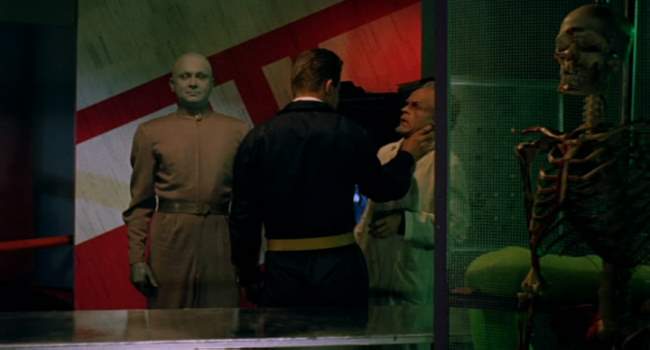
Overview: It’s a rare instance when we find a movie that has all the trappings of a “B” SciFi shlock-fest – one with an overly cheesy name, a DVD cover advertising the movie as a classic drive-in flick (as was the original marketing art), one which has the standard “B” movie high-pitched moaning female chanting alien vocal track duing the credits and a creature-feature font typeface for its title – but in fact isn’t. Creature of the Humanoids practically screams “low-budget, exploitative SciFi crapfest” but…isn’t. Instead, after digging beneath the voluminous trappings of “B” cinema, we find a very intelligent, but low-budget movie – one which in 1962 has captured a good number of the cyberpunk themes that would dominate literature and movies twenty years later. Contrary to the DVD cover, which combines Creation of the Humans with War Between the Planets (which is pretty much what you think it is), this is a slow-paced, thinking person’s movie. Said another way, I’d probably be damn bugged if I had taken a date to see this at a drive-in, but as an intelligent movie for CyberpunkReview, it works fine.
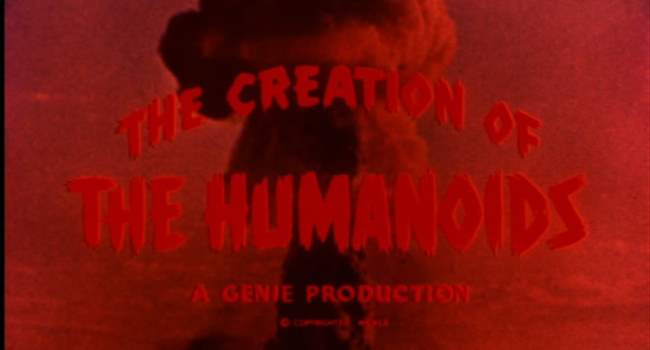
The Setting: A nuclear war has taken place, resulting in the extermination of 92% of the human race. Those that remain are riddled with radiation poisoning, leaving very few couples who can create viable offspring. To keep civilization running, the remaining humans significantly ramped up their production of robots, which now number almost a billion in total, and handle most of the mundane tasks of society. Over time, advances in AI and automation have created a “race” of robots that have become sentient, and even more capable than their human counterparts. Because humans couldn’t stand working next to machine-looking things that seemed smarter than them, robots began being constructed to emulate humans. Now, 20% of all robots look humanoid in nature. However a backlash has formed - a hate group called the “Order of Flash and Blood” is pushing for the ban on all humanoid-looking robots. Because of a backlash by many humans, these robots can only look 70% similar to humans.
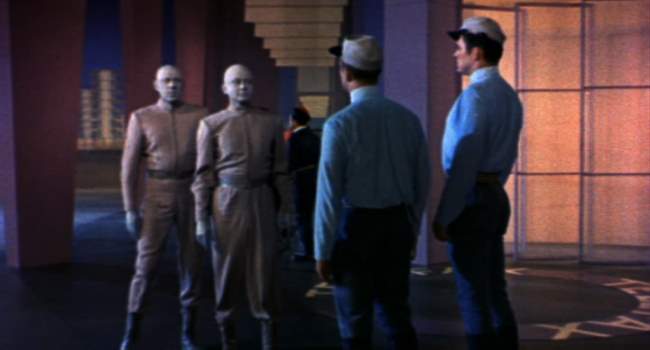
The Story: Capt. Kenneth Cragis (Don Megowan) is a leader in the Order of Flesh and Blood, the robot hate group. While on monitoring the activity of “clickers,” a derogatory term for robots, he notices some suspicious activity entering the robot shrine, a building off-limits to humans, which contains the central AI program that most robots now take direction from, and practically worship. In getting Flesh and Blood members to storm the shrine, they find a robot that looks almost fully human (96%) who has just killed a rogue scientist. As robots are all programmed to follow what essentially are Asimov’s three laws of robotics, this constitutes the first instance of a robot killing a human. Cragis sees this as an opportunity for the order to finally break-through and convince the human leadership of the righteousness of their cause. But in analyzing the human-looking robot, they discover something horrifying – it turns out that this robot actually “thought” he was a person, and appeared to have been created by taking the essence of a person recently dead, and replicating them inside of a robot.
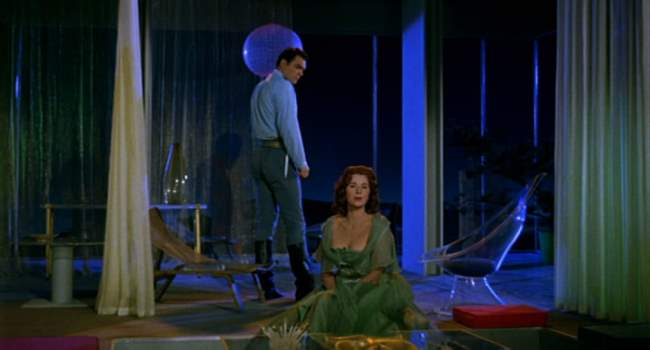
Cragis also has another dilemma, his position in the order is now threatened, as its come to light that his sister has recently entered “rapport” with a robot named Pax. When in rapport, the robot and human essentially share the same mindset – everything his sister desires is instantly understood by the Pax and her needs are met. They are essentially soul mates. Cragis and his sister are on complete opposite sides of this issue, and there is no way for him to convince her otherwise. But things go from worse to weird when Cragis, and his newly found love (Erica Elliott) discover a truth about themselves that will shake the foundations of humanity.
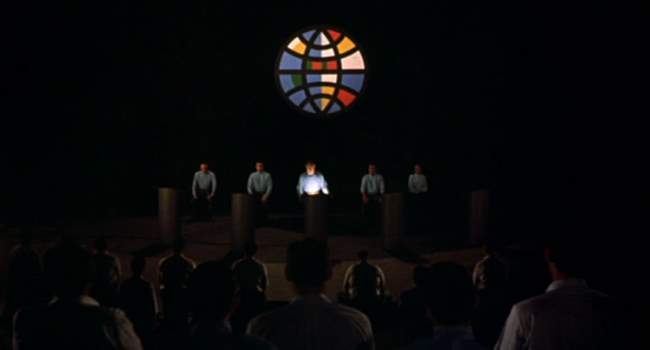
The Production Values Suck: If I were grading Creation of the Humanoids based on production values alone it would be grateful to achieve even a three-star rating. From a production value standpoint, this movie is poorly made. The very few sets that exist look like warehouse sets quickly done up with extra junk from other SciFi movies and the only music accompaniment used everywhere (including love scenes) is the eerie “alien ship is coming” sound. The FX, especially of the robots are very poor, consisting primarily of bald-hair pieces and green makeup. Aside for a few of the leads (Don Megowan, the most important character is decent) is sub par at best. From a production value standpoint, Creation of the Humanoids seems far better suited to a play than a movie. If fact, I wouldn’t be at all surprised if this was the original intention of Jay Simms’ script. The DVD treatment, which provides a far better than expected transfer, essentially tries to mimic a drive-in movie experience. This is annoying it that there is no chapter feature. You are forced to click through the upfront stuff, the first feature, and the intermission crap to even get to Creature of the Humanoids.
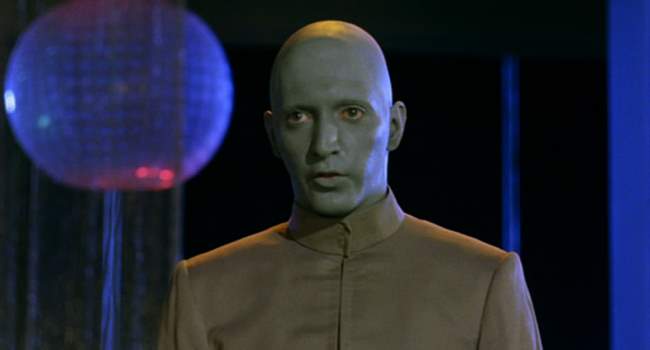
If a Man Loses His Leg, Is His Soul Affected? this is the question posed by Creation of the Humanoids. If one answers that the soul is not affected, the follow-on thought is what if the whole body was replaced but that the essence that is “you” survives in an android shell. Do you still have a soul? If not, when did you lose it? Creation of the Humanoids provides us a world where humans are quickly becoming extinct, and where their salvation is going to be a situation where their personalities – all that makes them unique – are transferred into robotic bodies. They even will still be able to procreate, after a fashion. So the larger question this movie finally poses is: in this completely post-human world, does humanity still exist?
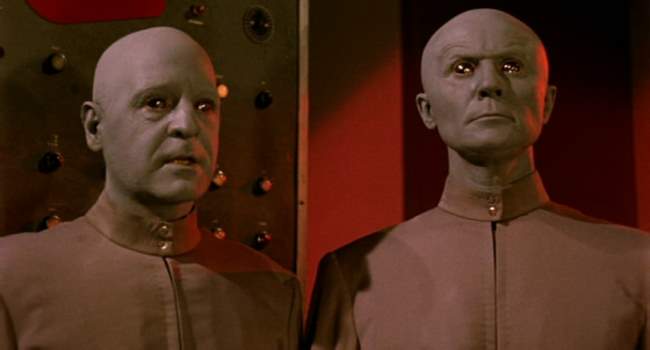
Replicants in Years Past: While Blade Runner is most often credited as having the definitive replicants, clearly this idea has been around for a lot longer. In Creation of the Humanoids, robots that are 96% human capability are created by taking a recently diseased person (within six hours of death) and extracting all that is unique about them (their memories, learning, skills, philosophy, etc.) and inserting it into a special thalamus chip to be integrated into a robot’s cerebral cortex processing unit. In doing so, they wipe all memory of the human’s last moments (their deaths). The end result are robots that still think they are human. For all times other than between 4:00 – 5:00 am, the robots act completely human. But during that one hour, they remember who they really are and report back to the robot society.
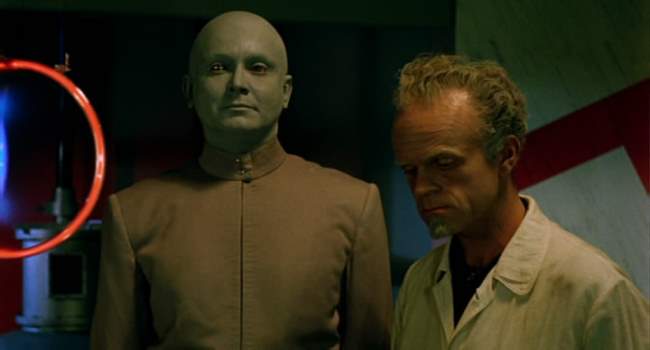
Asimov’s Laws Were Already Being Followed By 1962: Creation of the Humanoids gives us a glimpse of the incredible influence that Asimov’s “I, Robot” a mere 12 years later. The Robots in this already adhere to the laws, and have already worked out methods to break them. Robots must never harm other humans, and must always work to serve their best interests. Yet, unfortunately, humans don’t always know what is in their best interests, and thus, the robots must become subversive to meet this law.
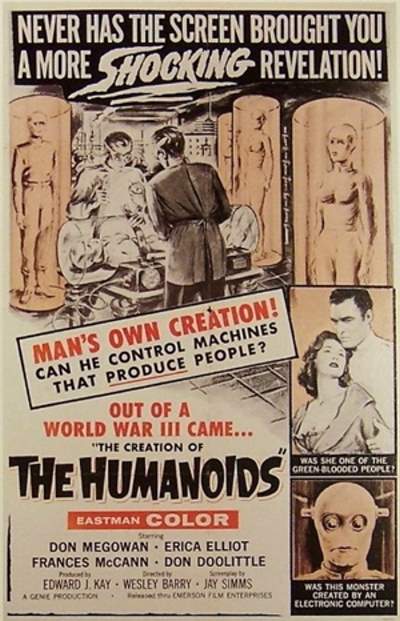
Clearly, this movie was created and marketed as a creature-feature. One can only imagine the disgust that writer Jay Simms had to this bastardization of his overly thoughtful script.
When Robots Control Humanity: One of the more interesting arguments Creation of the Humanoids engages in is the question of what life will be like if and when the robots control mankind. In this movie, the robots have already gained control of who is in gets elected, even though the regular populace has no clue this has occurred. The robots also engage in subtle methods of mind control and brainwashing, all to make the populace more accepting of robot rule. Because the robots believe humans do things not in their best interests, it becomes their duty to “manage” human life. The question is then raised whether humanity will still want to pursue knowledge and self-betterment – after all, what’s the point if everything you even think you might want is automatically provided for you? The answer is rather depressing here – it has already happened – that we’ve just now realized it is almost irrelevant.
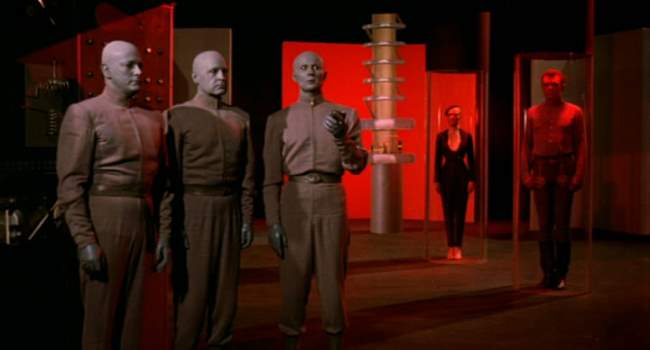
The Bottom Line: While the production values suck, the story in Creation of Humanoids is both complex and interesting. Many ideas presented are wonderful grist for later books and movies. As long as you realize that the production values in this flick make the old Dr. Who series look high-tech, you’ll probably enjoy it. While it is very slow-paced and only has about 5 separate scenes, the ideas presented are interesting enough to keep your attention. Aside for the commentary on race relations (obviously a big issue in the early 60s) Creature of the Humanoids makes us think through some interesting notions of post-humanity. While I’d give it 3 stars for its production values, I’d give it an 8 star rating for its story. This won’t appeal to everyone, but is certainly good enough that it shouldn’t be forgotten.
~See movies similar to this one~
Movie Review By: SFAM
Year: 1995
Directed by: Stephen Norrington
Written by: Stephen Norrington
IMDB Reference
Degree of Cyberpunk Visuals: Medium
Correlation to Cyberpunk Themes: Low
Key Cast Members:
Jack Dante: Brad Dourif
Hayden Cale: Ely Pouget
Sam Raimi: John Sharian
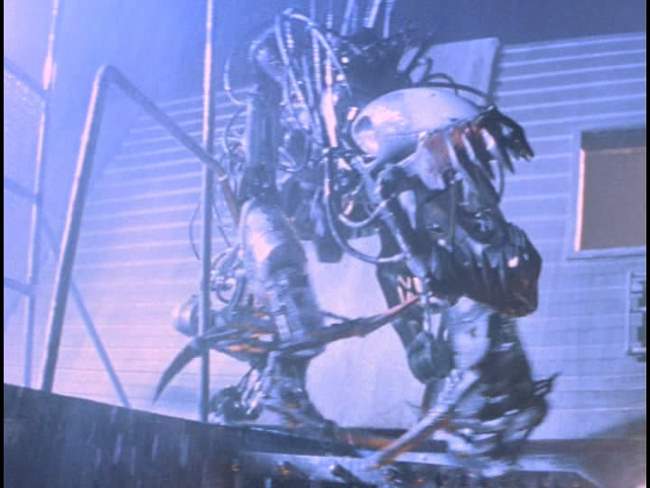
Overview: In yet another of the Alien/Terminator copycat movies, Death Machine is a low-budget, poorly thought out shlock-fest that tries to dazzle you with a largely incoherent in-depth plot and over-the-top acting. While another virtually unknown British Director, Richard Stanley, scored big in a similar but far more original copy-cat movie, Hardware, Stephen Norrington’s Death Match just doesn’t cut it. These types of movies live or die on the overall atmosphere and the quality of the fear the creature engenders. While Hardware excelled on both counts, Death Machine falls woefully short. Worse, Death Machine makes a lame attempt at humour by naming all the bit players with the names from the movies Norrington stole plot bits and visuals from (John Carpenter, Scott Ridley, Weyland, and Yutani)
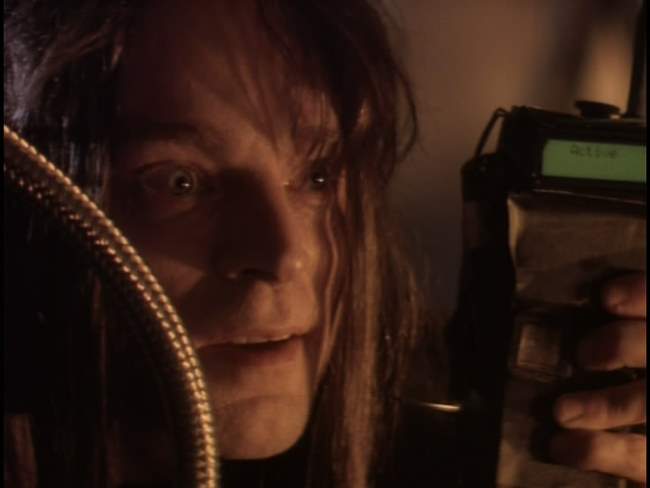
The Story: In the near-future, the evil Chaank Armaments corporation has engaged in a number of shady, classified project that have resulted in dissapearances and potential deaths. Public outcry has gotten out of hand, so for damage control, they bring in an upstanding principled new chief executive named Hayden Cole (Ely Pouget), a hot chick with a porn past to inspire trust and confidence amongst the masses. As she delves into things, it’s clear that the board of directors wants nothing to do with providing full disclosure. Why? Because there is an evil genius mad scientist in the basement named Jack (Brad Dourif), who has the dirt on everyone, and is hard at work at making a death machine to keep everyone in line. Additionally, Jack has created a process for transforming humans into killer-cyborgs. Unfortunately, this process is flawed, and all the cyborgs end up dying.
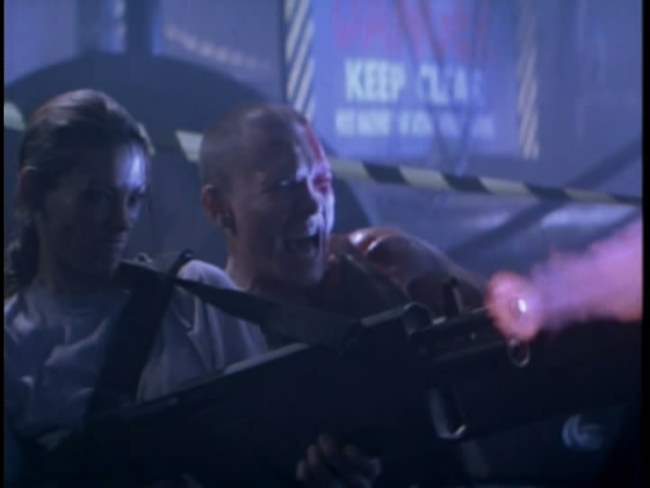
Eventually, the hawt chief executive challenges Jack, and all hell breaks loose. She and a few others become trapped in the building with some would-be amateur freedom fighter cyberpunk types who have invaded the corporation in the hopes of destroying it. Now they are all just trying to escape the robot known as the War Beast. Hayden and Sam Raimi (John Sharian), the leader of the amateur terrorists, spend the rest of the movie trying to evade and eventually kill the War Beast. I could go into more of the plot, but truly, its just not worth it.
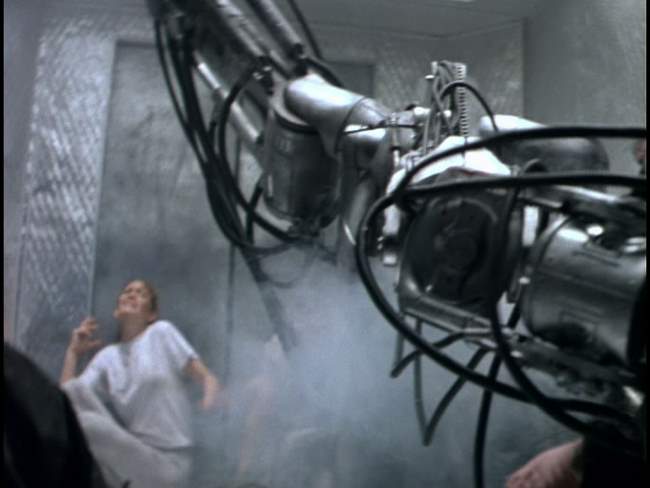
The Robot Monster: OK, so we have this really tough robot thing – virtually indestructible. Anyone wanna tell me why this robot has like a hundred rubber tubs hanging out, and nobody who fights it in hand-to-hand combat thinks of grabbing them? More to the point, why don’t the thousands of rounds of bullets affect the tubes? Bottom line, this robot was more silly than scary. In Hardware, the robot was continually shown moving quickly in low-light situations. This allowed Stanley to get away with a low-tech, but very believable robot. Unfortunately, Death Machine doesn’t take this approach – it shows the robot in detail to make sure you see its faults. Color me not impressed.
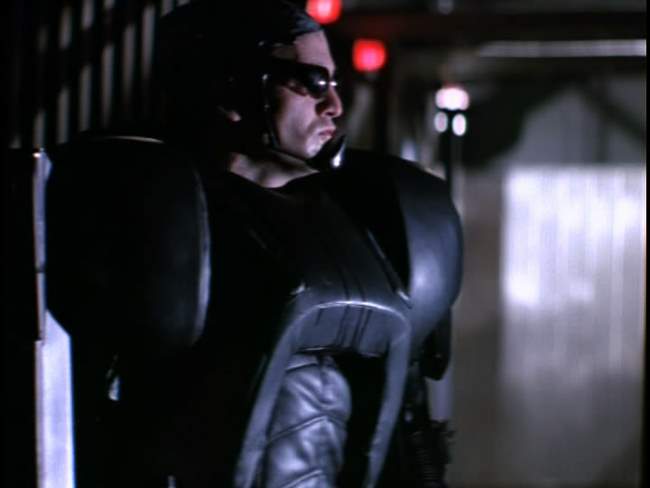
Yes, ladies and gentlemen, you can tell this is a cyborg because he’s wearing sunglasses. Also, he has that really big vinyl and plastic whatever-the-fuck-it-is on - DEFINITELY a sure sign of a cyborg warrior!
Death Machine’s Approach to Cyborgs: In Death Machine, the Chaank Armaments Corporation creates cyborgs by wiping someone’s memory and uploading it with detailed weapon systems training, and simple goals (e.g., protect me, seek out and kill “guy X”). In short, its approach to cyborgs assumes the human mind is synonymous with a hard disk. They even have an instance where a key character’s personality “backed-up” and then wiped from his mind to allow the “warrior personality” to be installed, and then later, they reload the initial personality. Puleeze, Norrington! I’m sure you coulda come up with a marginally believable cyborg warrior rationale. Too bad you didn’t take the time to think of one.
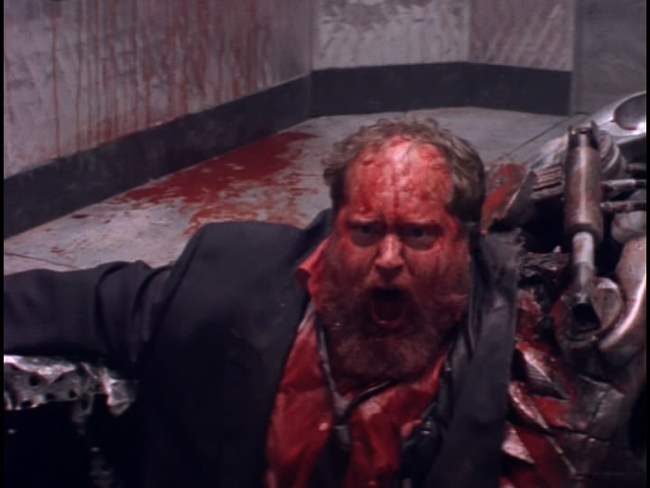
The Bottom Line: Truly, to even have a chance of being watchable, Death Machine would have needed to incorporate a heavy dose of T&A. While Ely Pouget has the looks, this never materializes. This is all the more annoying in that the inclusion of the porn reference flat out portends juicy T&A. Instead, we’re left with a shlock “B” movie, absent of T&A, without the effects, acting, plot or monster to carry the day. Brad Dourif’s character, while mildly amusing is just too over-the-top to stomach, and nobody else other than Pouget even stands out. Even worse, they screw up what should have been a very simple ending (this may be the only original part of the movie - in retrospect, Norrington should have copied this as well), leaving us with a almost complete let down, and no payoff for sticking around for 2 hours. In short, I don’t see much to recommend here.
~See movies similar to this one~
Game Review By: DannyV_El_Acme
Year: 2001
Author: Hideo Kojima and Kojima Productions
Platform: Other
Publisher: Konami
Price: I’ve seen it as low as $15
Degree of Cyberpunk Visuals: Very High
Correlation to Cyberpunk Themes: Very High

Introduction: With Metal Gear Solid, Hideo Kojima made a name for himself as one of the most gifted and ambitious video game designers today, so when the sequel to the game was announced, and moreover on the(then) brand-new PlayStation 2, fans were overjoyed. However, instead of a sequel which only included more of the same, Kojima used the power of the new system and DVD medium to create a game that defies characterization. Metal Gear Solid 2: Sons Of Liberty is one of the most ambitious, complicated, even puzzling games ever made. But even with all its differences from the original, it is still very much a Metal Gear game, so that guarantees an incredible storyline and intense, stealth-oriented action.
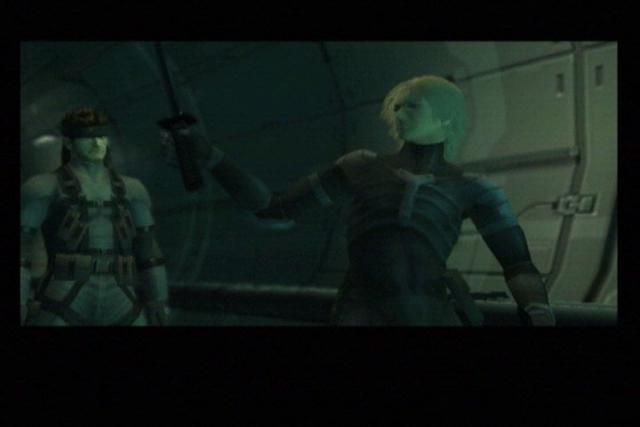
The story : Two years after the events of Shadow Moses, Solid Snake and Otacon are back on the field on a new mission. Snake and Otacon are now part of a UN-backed covert organization codenamed Philanthropy, whose purpose is the eradication of any and all Metal Gears around the world. Since Shadow Moses, plans for creating a Metal Gear have surfaced on the black market, leading to a multitude of clandestine organizations creating their own version of the dreaded war mech. At the start of the game, Snake and Otacon are particularly targeting a new amphibious model, Metal Gear Ray, developed by the U.S. Marines. However, things get ugly when the tanker carrying the new machine is hijacked by Russian military forces. During the course of the hijacking, Revolver Ocelot betrays his Russian comrades and, controlled by the spirit of thought-dead Liquid Snake, steals the Metal Gear prototype and sinks the tanker, causing an oil spill with Snake in it. Snake is presumed dead.
Two years later, on a routine visit to a plant created to control the oil spill, the President of the United States is kidnapped by a group calling themselves the Sons Of Liberty, led by a rogue black-ops group nicknamed Dead Cell. SEALs are sent to rescue the President, but the group is wiped out. As a last resort, the U.S. sends agent Raiden, a newly graduated member of Foxhound, to infiltrate the facility and rescue the President. However, as can be expected, this is no ordinary terrorist attack, and the facility houses secrets which point to a secret conspiracy only known as The Patriots. What do the terrorists want, and what does Raiden’s past have to do with the whole thing?
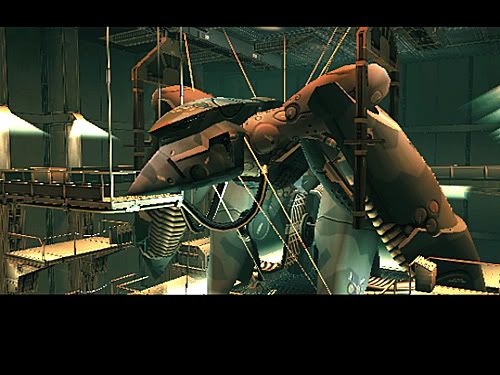
The game: While Metal Gear Solid’s story and themes are pretty straightforward and well established, MGS2 goes on a much more abstract direction. The dialog and situations in this game are much more bizarre and even postmodern than those in the previous game, and paranoia is rampant. This is the most cyberpunk of all the chapters in the series, this time the story focusing on meme theory, artificial intelligence, information control, conspiracy theories, and political and military maneuvering. But above all, the topic of the dehumanizing effect of technology and the influence of genetics in human behavior really make this a fascinating game to analyze with others. Like with The Matrix trilogy, a straightforward first chapter leads to a much more complicated second one which may divide fans and confuse newcomers. However, it is this complexity which makes this probably the most important game in the series yet. The game has a sense of urgency and even fatalism that moves one to try to solve the problems contained therein, but it also constantly dangles a thread of hope to grab on to. This is probably Kojima’s most personal game, and it shows.
Like the previous game, the action itself is stealth-based, but this time Snake and Raiden are MUCH better prepared and capable of dealing with the game’s dangers. The jump to a new system has resulted in a much more complicated game, but also one you have more tools for taking it on with. Enemies don’t instantly sound the alarm when they see you anymore, instead they have to radio in before an alarm is called. This gives you an extra second to dispose of the enemy before they alert their comrades. However, once an enemy is incapacitated, his friends start looking for him when he doesn’t report in, so you might want to hide the body somewhere. You can also knock enemies out or put them to sleep instead of killing them, which would cause less of a fuss than a body would(enemies even humorously kick friends awake when they’re dozing). Your characters are much more athletic, too, able to flip out of gunfire’s way, and hang from ledges to hide from foes.
The cast in this game is just as great as the previous game. Snake’s a little lighter in attitude and able to crack a joke, having made some new and faithful friends in the previous game, and Otacon’s friendship with Snake has deepened his resolve and made him a little more sure of himself. The new characters are great, too, although some people might be put off by Raiden, the new protagonist of the series. And if Psycho Mantis was freaky, Vamp is off-the-hook SCARY.
The jump from 32-bit to 128 did wonders for the game’s graphics. This game came out in 2001 and it STILL looks amazing. The amount of details in this game is incredible, and character models look gorgeous. The game is also much more cinematic, with expert direction during cinemas that makes the game even more of a blockbuster than the first. The music is also on a whole different level, composed by Harry Gregson-Williams, of The Rock, Armageddon and Enemy Of The State fame.
Availability: The game is just as available as MGS1, with many different versions. The recommended version is MGS2: Substance, the special edition of the game with lots of extra goodies. However, GET THE PS2 VERSION. The XBox version is a glitchy mess of slowdown.
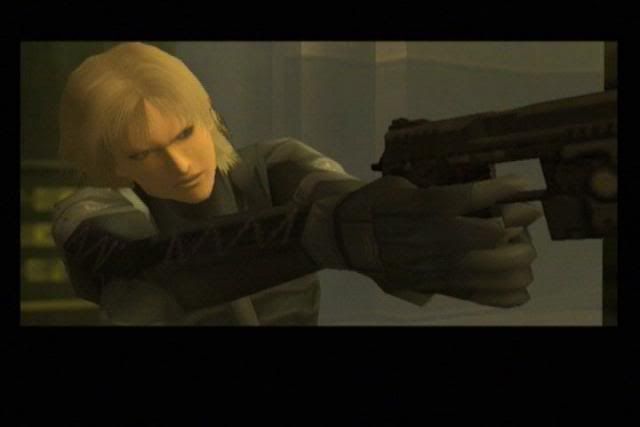
The verdict : MGS2 is a worthy followup to the amazing game that was MGS, and stands on its own both as an entertaining game and a fascinating document of electronic literature. I sadly have to dock it a point because it isn’t the easiest game to follow(probably the same reason that made SFAM give Matrix Reloaded 9 stars instead of 10), but that’s just being fair to the first one. And it’s still a spectacular game. 9 out of 10 stars: get it, play it, be thoroughly puzzled yet amazed.
Game Review By: DannyV_El_Acme
Year: 1998
Author: Hideo Kojima and Kojima Productions
Platform: Other
Publisher: Konami
Price: Around $25 or less right now
Degree of Cyberpunk Visuals: Very High
Correlation to Cyberpunk Themes: Very High
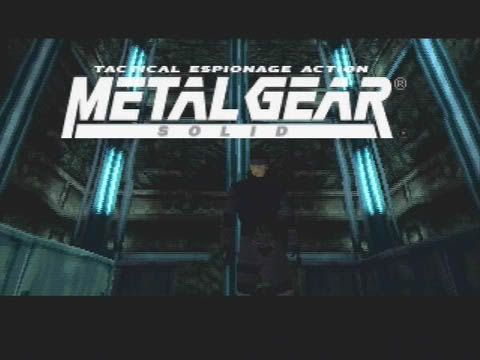
Introduction: There are few video game creators today as revered as Hideo Kojima. A producer/director of superb storytelling talent and limitless creativity, he is respected and admired by both gamers and fellow video game developers. Even mighty Shigeru Miyamoto, creator of Super Mario and the father of modern video gaming, is a declared fan of Kojima’s work. However, Kojima was a relative unknown as little back as 8 years ago, until Konami gave him the go to create this, Kojima’s first modern gaming masterpiece, Metal Gear Solid. While at first glance a military game, Metal Gear Solid is actually a deep cyberpunk analysis of warfare and morality, topics that Kojima had been exploring for years, but for which, before the creation of the Playstation, he had no hardware powerful enough to tell the story with. Thankfully, he finally did, he finally made the game, and he reinvented a lowly NES game into one of video gaming’s most respected and acclaimed franchises.
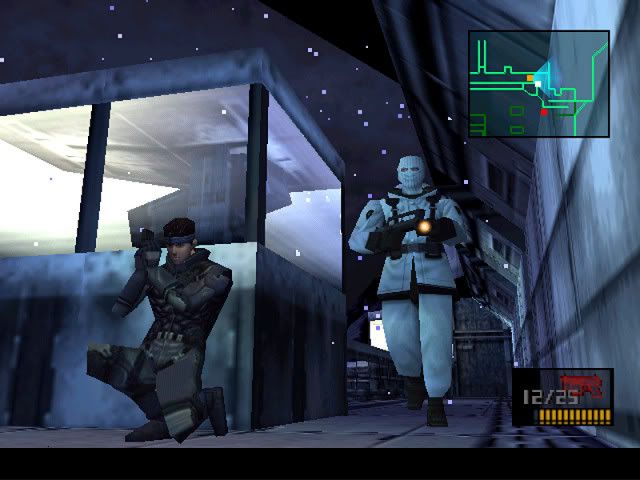
The Story : A nuclear weapon disposal facility on Shadow Moses, an island off the coast of Alaska, is invaded by an army of Genome Soldiers(genetically enhanced super-soldiers) led by Foxhound, a U.S. covert special ops team. The Genome Soldiers are dying, victims of genetic disorders caused by the gene therapy. Foxhound’s leader, Liquid Snake, makes a list of demands: one billion dollars and the body of Big Boss, Foxhound’s former CO and the one whose genes the Genome Soldiers are based on. Should the United States fail to comply, Foxhound will launch a nuclear warhead at the nation’s capital.
A direct attack on Shadow Moses may cause nuclear retaliation, and the presence of nuclear warheads in the facility is a secret from the world at large, so a media leak would be catastrophic. To make matters worse, Foxhound is the nation’s most elite special forces unit, each soldier capable of slaughtering entire platoons with ease. The Pentagon decides to “persuade”(i.e. force) retired Foxhound agent Solid Snake to infiltrate Shadow Moses and stop the terrorists through covert action. Armed with only his wits, radio communication with various mission analysts, and whatever he can find at the base, Snake must rely on stealth and cunning to complete his mission. However, there is MUCH more to Shadow Moses than meets the eye, secrets that could put the entire world in jeopardy, secrets dealing with Solid Snake’s shadowy past.
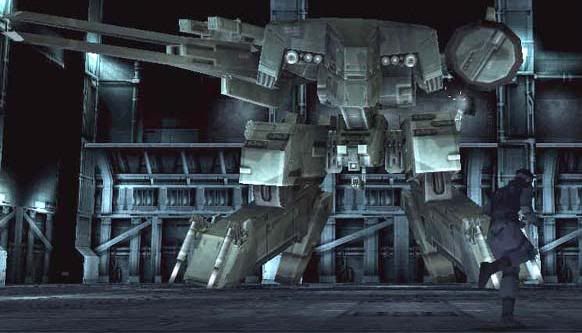
The Game: If I said in my Deus Ex review that I didn’t want to spoil the story because it’s so good, this is INFINITELY truer with Metal Gear Solid. Although Deus Ex is a more “authentic” cyberpunk game, Metal Gear Solid can only be described as a playable blockbuster film. It is truly an amazing experience in storytelling, and my personal favorite videogame franchise.
The gameplay itself relies heavily on stealth. While Solid Snake is a formidable combatant, he is hideously outnumbered by much better armed forces actually looking to shoot him down. Snake must remain hidden and either bypass his enemies or eliminate them as silently as possible. Luckily, Snake is a superb covert operative, and he can use the environment in truly ingenious ways to hide, distract and dispatch the enemy. Snake also has various tools to help him. Throughout the game, he will find weapons and gadgets of all kinds, from infrared goggles to assault rifles, and even the now famous cardboard box to hide in. He also has a radar that permits him to not only determine enemy position, but also their line of sight, enabling him to sneak where the enemy can’t see him. However, this radar gets jammed if Snake is seen, and Snake must RUN AWAY as fast as he can until things cool down!
Snake also has a CODEC built into his ear, which enables him to access a multitude of helpers to give him information, tips and moral support throughout the game. The CODEC conversations are truly one of the game’s greatest strengths. They showcase the characters as more than mere cardboard cutouts. During the game, the nature of conversations will range from simple mission objectives to discussions on morality, technological development, politics, human rights, and even what it means to be human. Topics such as genetic engineering, the arms race, nuclear energy, cloning, nanotechnology, biological warfare and many more are expertly discussed. This makes for quite an endearing cast, they are truly intelligent people with their own opinions and beliefs. This is where the game’s cyberpunkness shines through. The way the game explores technology, it’s impact on society and the military in particular, and the morality of technological development are ESSENTIAL elements to the game’s story that continue to resonate through all chapters of the saga. Metal Gear Solid establishes the base for future games of the series to develop these concepts even more thoroughly.
And on that note, we see the game’s greatest strength: the characters. Kojima has created a truly spectacular cast, no character is wasted or underdeveloped. From the cynical and gruff Solid Snake to the spunky and optimistic Meryl and scientist/über-nerd Otacon, the characters are diverse and uniformly interesting. The bad guys are truly an awesome force, too. From the enigmatic Liquid Snake to the sadistic gunman Revolver Ocelot and the oh-so-sexy Sniper Wolf, Foxhound’s members are quite the match for our heroes.
Visually, the game couldn’t be more cyberpunk. Greens, blues and grays dominate the color scheme, with cold metal surfaces everywhere. Cybernetic ninjas with Predator-like cloaking devices, gigantic mecha, you name it. This game wears not only its cyberpunk roots, but its anime roots as well, on its sleeve with pride. Cinemas are expertly directed, giving the game an A-list action movie fell. AND THE VOICE ACTING!!! This is the absolute GREATEST voice acting EVER. David Hayter has actually made a career out of his work as the voice of Solid Snake, and the whole cast is composed of voice acting veterans from a multitude of games and anime. Metal Gear Solid established the standard for voice acting in the video game industry.
Availability: Honestly, if you can’t find this game, something’s SERIOUSLY wrong with you. There have been myriad releases of the game, including a Playstation Greatest Hits release, a PC version, and even a remake for the Gamecube(dubbed The Twin Snakes) which updates the game with next-gen graphics and gameplay elements from its sequel, Metal Gear Solid 2: Sons Of Liberty.
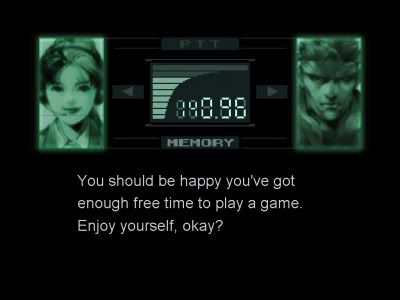
The Verdict : If you want the closest thing to a playable cyberpunk/military movie or anime, Metal Gear Solid is truly it. This is videogaming at its finest, and it has rightfully been called a masterpiece the world over. Get this game and play it, just so you know what comes before Metal Gear Solid 2. My highest recommendation, this is my all-time favorite video game series. And maybe once you play it, you’ll know why too. I(and half the press, already) give Metal Gear Solid a perfect ten stars.
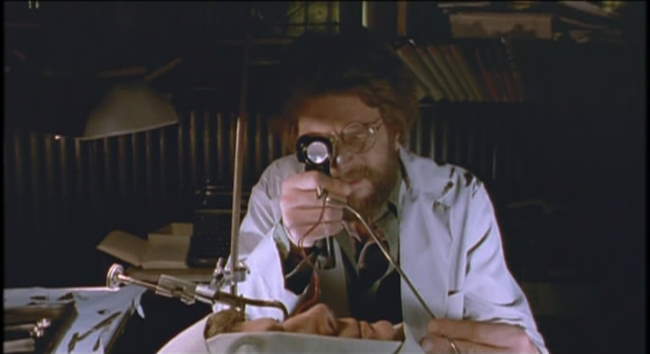
Every now and then I like to update everyone on the site access and growth. I truly do appreciate especially the participation we’ve gotten here both with the comments (almost 1400 comments in total), and in the immense help so many have given in uncovering all these wonderful cyberpunk films (and even some of the “less than wonderful” ones). I absolutely love spending time building this site, and even though I don’t earn a dime off of it (generating ad revenue off of spreading the love for cyberpunk concepts seems wrong at some fundamental level), I really value CyberpunkReview more than I can express. Given this, and my relatively meager time I’ve been able to spend on CyberpunkReview for the first month since I’ve started, I’m shocked at the continued upswing in growth that July has shown. At the end of March, when I last did the stat thing, CyberpunkReview had almost over 8300 visits (267 per day), 37,000 page views (meaning the number of times a page on CyberpunkReview was requested) and just over 300,000 hits. Here’s what the stats looked like for January (search engine bot hits not included):
July 06 Statistics
- Total Visits: 19,877
- Average Visits Per Day: 641
- Total Page Views: 66,885
- Total Hits: 652,189
This is a doubling of the March statistics, but truly, July is a significant jump over June (almost 14,000 visits) as well. Overall, CyberpunkReview has had over 275,000 page views, and over 69,000 visits from almost 34,000 unique visitors (meaning about half the visits are from repeat visitors). In looking at the growth, I tried to figure out where this was coming from, and had hypothesized that there was a huge jump in search engine hits. Back in March, 49% of the site access came from a direct address (meaning someone typed or bookmarked “CyberpunkReview” to get here), 9% came from search engine hits, and 42% came from links from an external page (860 external links in all). In July, 51% of the site access came from a direct address/bookmark, 12% came from search engine hits and 37% came from external links (1184 in all). So really, to the extent things have changed, there has been a slight increase percentage wise in search engine hits, but the majority has come from direct links.
International Access
International access, while still growing wonderfully, has dropped as a total percentage of the hits. Previously, 40% of all hits used to be international; now this is somewhere around 33%. Interestingly, some of the increased US hits are graphic links - for instance, MANY sites in MySpace have linked to images here at CyberpunkReview. In any event, here are the top international country groupings accessing CyberpunkReview, along with the total page views from each:
- European Union - 2521 page views
- Australia - 2118
- Germany - 1680
- Great Britain - 1675
- Canada - 1015
- Sweden - 768
- Spain - 651
- Japan - 543
- Netherlands - 526
- Switzerland - 493
- Belgium - 439
- China - 384
- Russian Federation - 350
- Greece - 319
- Denmark - 284
- Poland - 284
- Hong Kong - 277
- Puerto Rico - 248
- Yugoslavia - 223
- Brazil - 221
- Czech Republic - 203
- Slovak Republic - 196
- Portugal - 187
- France - 162
- Others (and unidentified) - 5621
Visitor Machine Profiles
Operating Systems: 89% of all visitors have MS Windows for their operating system. 6.5% use Macintosh, 2.2% use Linux, and less than 1% use FreeBSD, Sun Solaris, WebTV (25 hits for this one), and NetBSD.
Browsers: MS Internet Explorer won July with 46% of all hits, whereas Firefox came in second with 38% (common folks! Go Firefox!). Opera accounted for 7%, Safari for 4.4%, and Mozilla, Netscape, Konqueror, Camino, and NetNewsWire accounted for less than 1% each.
Top Accessed Pages
Not surprisingly, as a single page, the RSS news feed has pretty much dominated everything else. Over 15,000 page views came from the RSS feed in July. For actual posts or category groupings, the breakdown is as follows:
- Cyberpunk Movies by Decade
- Ultraviolet
- Tetsuo (The Iron Man)
- What is Cyberpunk?
- Fragile Machine
- Texhnolyze
- Ghost in the Shell
- Ghost in the Shell Stand Alone Complex
- A Scanner Darkly
- Serial Experiments: Lain
- Awesome Cyberpunk Visuals
- Total Recall
- Aeon Flux
- Blade Runner
- Armitage III
The Meatspace
The Meatspace Forum is still growing wonderfully. We have 95 members now, and there have been a some terrific discussions. Please join up! We’d love to have you participate!
Spam!!!
Aside from getting 1-2 bogus accounts on the Meatspace every day (I delete these every few days), I’ve had over 260 spam comments uploaded to the site. While you would think this would be a nightmare to manage, the Akismet plugin has been a Godsend. I think that less than 10 spam comments have actually made to the site - all the rest were captured by Akismet, providing me easy deletion of them. For the spammers, I’ve gotten an insane number of ringtone comment ads, and a surprising number of japanese ads.
Still Looking for Reviewers
We’re still looking for more reviewers for Cyberpunk Review. Especially of interest are those interested in doing book, music and graphic novel reviews, but if someone wants to do cyberpunk art reviews, or cyberpunk internet short reviews, this would be great too. We have about 5 people on and off doing game reviews, but to date, we’ve only had one person (David Gentle) who’s done a book review for us. I’m eagerly looking forward to more from him, but clearly, cyberpunk books comprise the bulk of the content in the cyberpunk genre. If you have an interest, PLEASE PLEASE let me know. There’s a reviewers forum in the Meatspace that can give you some basic info on this.
And thanks again for stopping by. And especially, thanks to all of you who’ve been participating in the comments and the discussions in the meatspace.
This post has been filed under Site Development by SFAM.
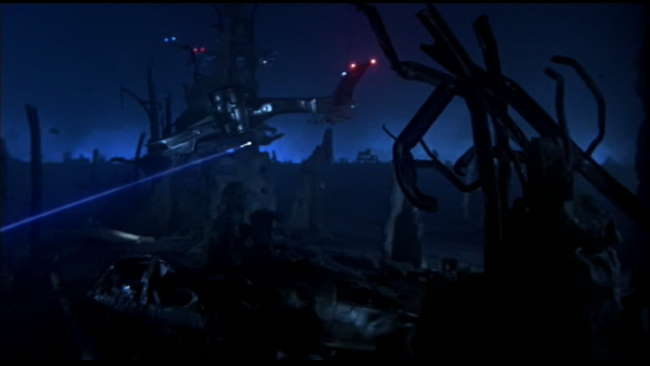
William Gibson posted a pretty interesting Blog entry a few days ago on the mismatch between the US’s military approach with what actually seems to be the direction of modern warfare. The idea of fourth generation warfare is raised. Wikipedia defines fourth generation warfare as follows:
Fourth generation warface is used to describe warfare’s return to a decentralized form. In terms of generational modern warfare, the fourth generation signifies the nation states’ loss of their monopoly on combat forces, returning in a sense to the uncontrolled combat of pre-modern times. The simplest definition includes any war in which one of the major participants is not a state but rather a violent ideological network. Fourth Generation wars are characterized by a blurring of the lines between war and politics, soldier and civilian, peace and conflict, battlefield and safety. While this term is similar to terrorism and asymmetric warfare, it is much narrower. Classical examples, such as the slave uprising under Spartacus or the assassination of Julius Caesar by the Roman senate, predate the modern concept of warfare and are examples of the type of combat modern warfare sought to eliminate. As such, fourth generation warfare uses classical tactics—tactics deemed unacceptable by the preceding generations—to weaken the technologically advantaged opponent’s will to win.
Gibson uses Thomas Khun’s notion of a paradigm shift (yes, this is a completely overused word) to describe the the change in the nature of warfare that seems to be well underway and speculates as to why the US hasn’t recognized the shift. In the end, Gibsons states:
The bad news is that the policy-makers of the United States and Israel apparently (still) don’t get the new paradigm, and the bad news is that Hezbollah (et al, and by their very nature) do. Though that’s only bad (or double-plus-ungood) if you accept, as I do, that the new paradigm allows for a more effective understanding of reality. So if you still like to pause to appreciate the action of phlogiston when you strike a match, you may well be okay with current events. So many, God help us, evidently are.
Here the US has spent billions on creating the groundwork for proto-Skynet, and unfortunately it seems that our adversaries have already passed us by. While we waste close to a hundred billion acquiring the F-22, a supra-awesome dogfighting plane who’s utility vanished when the wall fell, our adversaries have already adapted to this 4th generation warfare paradigm. In practice, it’s as if we’re trying to squash a thousand ants with an oversized hammer, while trying to be careful not to hit the non-combatants standing right next to the terror-ants. The terrorist organizations recognize that when the “dominant” force kills civilians, they lose in the court of public opinion (never mind the beheadings - these don’t count, right?). Worse, when the weaker force merely survives, this now translates as a victory. All this seems to significantly weaken the power of the aggressor’s advantage.
This notion of decentralized warfare seems to go in line with a range of changes. In a networked society, perhaps the notion of centralization itself has become obselete. We see huge tensions now with invasions of privacy rights, supra-search engines scanning through everything and so forth - all signs of a centralized control system asserting its power. But you almost have to wonder if we’re really just seeing the equivalent of a rubber band stretching past its tolerance levels in an attempt to keep a hold on everything. The fear of course is it eventually breaks, and social order comes crumbling down with it.

So what’s a useful strategy for a dominant power to win in a 4th Generation War? Clearly, the conventional tools of domination have lost their importance. Perhaps the answer is to become decentralized as well - to fully embrace a net-centric method of warfare in a way that emphasizes one to one combat, but one which still utilizes the technological advantage. One can almost envision a cyberpunked mecha-force coming to fruition, where high-tech soldiers are encased in armor and become the equivelant of ultra-mobile tanks invading the battlefield. Then again, perhaps a better strategy for victory is more complex, more nuanced, and involves more sedate methods of control. I know engagement and diplomacy don’t seem very sexy, and rarely seem to amount to significant progress, but perhaps a “sexy veneer” can be added to make this alternative seem more enticing.
In any event, its not too hard to imagine a scenario where a continued course in the current direction has a strong possibility of creating a cyberpunked dystopia not unlike some of the movies on this site. While that’s probably good for business here at CyberpunkReview (that is, if I was attempting to generate revenue from this site), unfortunately, I’m guessing it would be somewhat detrimental for the society at large. Then again, what’s the cyberpunked version of that old expression? Ah yes, “Think Locally, Act Globally!” Good for business indeed.
This post has been filed under Cyberpunked living by SFAM.
WordPress database error: [You have an error in your SQL syntax; check the manual that corresponds to your MySQL server version for the right syntax to use near '' at line 1]
SELECT COUNT(ID) FROM
|




































